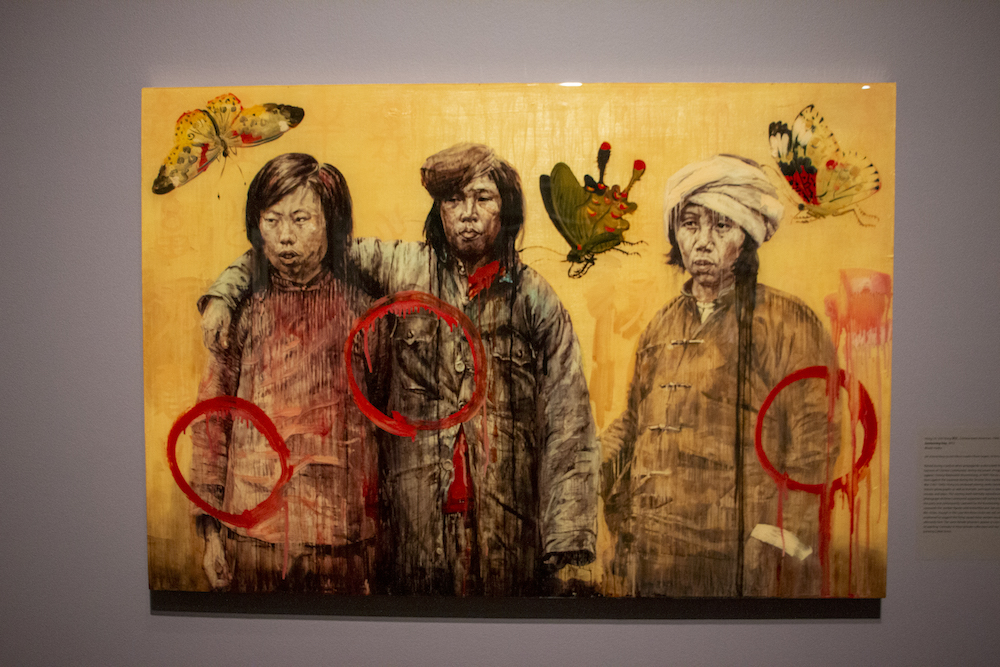In 2018, the Jordan Schnitzer Museum of Art on the University of Oregon campus received an incredible donation of 55 mixed-media works by Chinese-born American artist Hung Liu. The new exhibit, “Remember This: Hung Liu at Trillium,” celebrates this meaningful gift and also mourns Liu’s untimely passing from pancreatic cancer in August 2021, at the age of 73.
“We share this collection with great pride, but there’s a gaping hole in the middle,” says Anne Rose Kitagawa, JSMA chief curator of collections and Asian art and director of academic programs. “We were thrilled by the incredible opportunity to feature Hung Liu’s art and to bring her here to interact with faculty and students, so her absence is such a huge loss. Of course, at the time we were planning she had no idea she was unwell.”
Hung Liu was born in China in 1948. She lived through difficult times before, during, and after China’s Cultural Revolution, including four years in the countryside working in the fields with peasants. Later, she was able to study mural painting at the most prestigious art academy in Beijing but she yearned for more freedom than the strict training in propaganda art would allow. For example, using photographs as models for paintings was not permitted but Liu had taken photos of the farmers that inform some of her later work. In 1984, after four years waiting to get a visa, relocated to the United States to study art at UC San Diego. There she worked with avant-garde professors and enjoyed greater artistic freedom. Eventually she became one of the most important Chinese artists in the U.S., garnering acclaim for her powerful paintings and installations.

In 2003, Liu began working with master printer David Salgado at Trillium Graphics in Brisbane, California. Together they developed a unique hybrid technique combining elements of printmaking, photography, and painting between multiple layers of clear resin. Based in part on hi-res digital photos of Liu’s paintings, these works allowed her to revisit, recombine, and embellish aspects of those previous subjects. Often, these mixed-media works were created over a metallic base layer that reflects light and colors. Close looking reveals shadows between the layers, giving clues about the order in which the elements were added.
Tragically, David Salgado died in 2018 shortly after announcing their donation. The JSMA’s plan was to feature Hung Liu’s mixed-media exhibition in 2021, but due to the pandemic it was postponed so the artist could attend the opening and a series of public events. Without her, the works have to speak for themselves.
Kitagawa installed many of Liu’s monumental mixed-media pieces; the largest is more than 20 feet wide. Unlike other shows that are contained in a single gallery, Kitagawa placed some of Liu’s works in the museum’s Chinese gallery, where they act as bridges between traditional and modern China. There are also two large Hung Liu works on view in the JSMA lobby — a set of 12 profiles of a Chinese woman based on 19th century photographs by Western photographers who approached foreign subjects as specimens rather than people. Each panel is a 12-inch diameter circle and includes a flower representing one of the 12 months. On the opposite wall is a poignant Hung Liu work based on Dorothea Lange’s famous Dust Bowl portrait “Migrant Mother.” At the end of her life, Liu recognized the values she had in common with Lange, namely their desire to portray those forgotten by society with compassion and a sense of social justice.

Hallmarks of Liu’s painting are rich colors, mineral oil drips that threaten to disintegrate her subjects, and Zen ensō-like gestural circles that seem to have different meanings depending on how and where they are used — to represent time, to represent the heavens, or even the crosshairs of a gun. She did the same in her mixed-media works. Many are based on historical photographs of China such as a 19th-century image of a young girl with bound feet, or a mid-20th-century one of three female Communist sympathizers just before their execution. They are also filled with imagery drawn from traditional Chinese art such as flower blossoms, birds, figures, and landscapes juxtaposed in a manner reminiscent of decoupage.
“Hung Liu found ways to undermine the Western prejudices and exotic fantasies about Chinese people,” says Kitagawa. “And she did interesting things with her mixed media pieces, embellishing them with flower petals and candles almost as though she was adding ritual offerings. And all those drips and circles — she almost vandalizes her own work. Such expressionistic elements would not have been welcome in the Chinese socialist realist art she originally studied, because they would have undermined the propagandistic message by imposing a destructive element of time.”

Liu’s techniques allow her to restructure those old historical photos or symbols and infuse them with a new light — and perhaps, in a sense, destroy them. As the layers develop, so too do the memories, so too do years pass, so too does power degrade and history uplifts those who were once downtrodden. We no longer have Hung Liu to talk about her intentions, but we have her breathtaking art, and it is filled with clues about the many profound things she wanted to say.
Remember This runs through August 28 at the University of Oregon’s Jordan Schnitzer Museum of Art.


